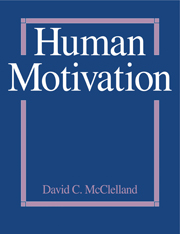Book contents
- Frontmatter
- Preface
- Foreword
- Contents
- Part 1 Background
- Part 2 The Nature of Human Motives
- 4 Emotions as Indicators of Natural Incentives
- 5 Natural Incentives and Their Derivatives
- 6 Measures of Human Motive Dispositions
- Part 3 Important Motive Systems
- Part 4 Contextual Effects on Human Motives
- Bibliography
- Acknowledgments
- Index
6 - Measures of Human Motive Dispositions
Published online by Cambridge University Press: 05 July 2014
- Frontmatter
- Preface
- Foreword
- Contents
- Part 1 Background
- Part 2 The Nature of Human Motives
- 4 Emotions as Indicators of Natural Incentives
- 5 Natural Incentives and Their Derivatives
- 6 Measures of Human Motive Dispositions
- Part 3 Important Motive Systems
- Part 4 Contextual Effects on Human Motives
- Bibliography
- Acknowledgments
- Index
Summary
• THE MOTIVATIONAL SEQUENCE
What is needed now is a general model of motivated behavior. Experimentalists deal with motivation—with short-term situational influences like food, variety, requests for obedience, or electric shock that arouse approach or avoidance behavior immediately. Personality theorists or clinicians typically think in terms of motives, that is, stable dispositions that organize or explain much of what a person says and does. How do these two approaches fit together? What exactly is a motive disposition, and how should individual differences in its strength be measured? According to clinicians, some people, like Freud, have a strong need for fame, recognition, or power. How do we determine how weak or how strong the power motive is in different individuals? How is a disposition like the power motive aroused by a Situation, and when aroused, how does it influence what the person does? These are the questions to which this chapter is addressed.
Motives are based on emotionally arousing incentives, which were discussed in the previous chapters. The incentives Start out by being natural in the sense that they innately give rise to different types of positive or negative emotions. As we have seen, however, their nature changes rapidly with learning.
- Type
- Chapter
- Information
- Human Motivation , pp. 172 - 220Publisher: Cambridge University PressPrint publication year: 1988



